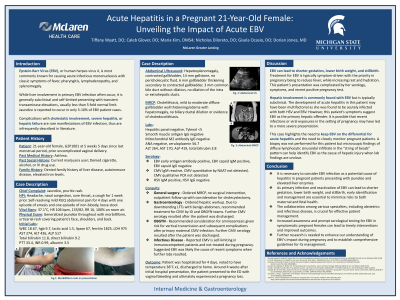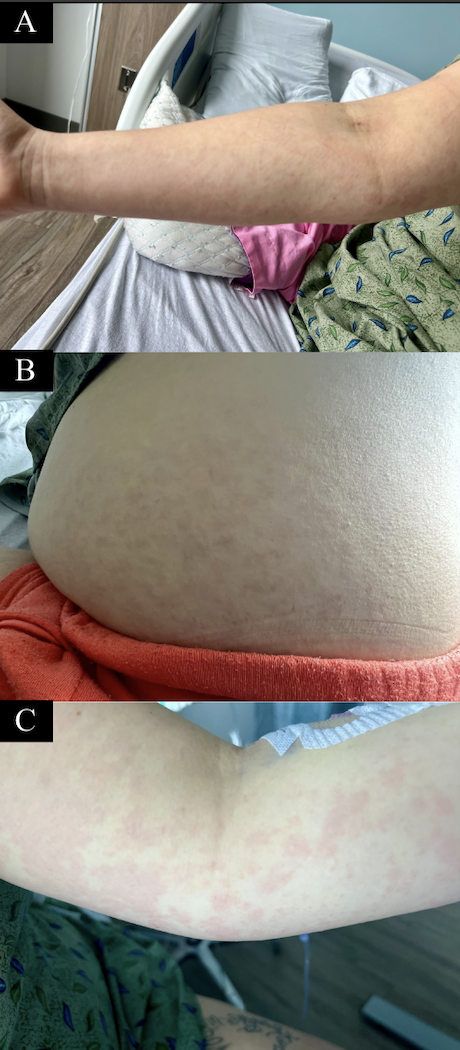Monday Poster Session
Category: Liver
P3024 - Acute Hepatitis in a Pregnant 21-Year-Old Female: Unveiling the Impact of Acute EBV
Monday, October 28, 2024
10:30 AM - 4:00 PM ET
Location: Exhibit Hall E

Has Audio

Tiffany Wyatt, DO
McLaren Greater Lansing Hospital
Lansing, MI
Presenting Author(s)
Tiffany Wyatt, DO1, Caleb M. Glover, DO2, Maria Kim, BS3, Nicholas Diloreto, DO1, Gisela Ocasio, DO1, Dorian Jones, MD1
1McLaren Greater Lansing Hospital, Lansing, MI; 2McLaren Greater Lansing Hospital, East Lansing, MI; 3Michigan State University, Lansing, MI
Introduction: Epstein-Barr Virus (EBV) is most commonly known for causing acute infectious mononucleosis with classic symptoms of fever, pharyngitis, lymphadenopathy, and splenomegaly. Liver involvement in primary EBV infection is often subclinical, generally presenting with transient transaminase elevations usually less than 5-fold normal limit. Jaundice is reported to occur in only 5-10% of cases. Complications with cholestatic involvement, severe hepatitis, or hepatic failure are rare manifestations of EBV infection, thus are infrequently described in literature.
Case Description/Methods: A 21-year-old pregnant female presented to the hospital's emergency department with complaint of jaundice and pruritic rash. She experienced headache, nasal congestion, sore throat, and a cough a week prior to her presentation. She had mild right upper quadrant abdominal pain 4 days prior to arrival but ultimately presented after developing jaundice and a pruritic rash covering her face, left shoulder, and back. Initial labs demonstrated the following: WBC 18.67, AST 274, ALT 426, ALP 517, total bilirubin 11.8. Abdominal ultrasound and MRI demonstrated hepatosplenomegaly, contracted gallbladder, cholelithiasis without ductal dilation, and gallbladder wall thickening. A serological workup demonstrated the patient to be EBV early antigen antibody positive, EBV capsid IgM positive, EBV capsid IgG negative, CMV IgM reactive, CMV quantitative by NAAT not detected, HSV IgM positive, HSV IgG negative. Gastroenterology, obstetrics/gynecology, general surgery, and infectious disease services were consulted during her hospitalization.
Discussion: Hepatic involvement is commonly found with EBV but is typically subclinical. The development of acute hepatitis in this patient may have been multifactorial as she was found to be acutely infected with both HSV and EBV. However, her symptoms suggest EBV as the primary hepatic offender. This case was further complicated by the patient's serology, symptoms, and recent positive pregnancy test. It is possible that recent infections or viral exposures in the setting of pregnancy may have led to a more severe presentation. This case highlights the need to keep EBV on the differential for acute hepatitis and the need to closely monitor pregnant patients. A biopsy was not performed for this patient but microscopic findings of diffuse lymphocytic sinusoidal infiltrate in the “string of beads” pattern can help identify EBV as the cause of hepatic injury when lab findings are unclear.

Note: The table for this abstract can be viewed in the ePoster Gallery section of the ACG 2024 ePoster Site or in The American Journal of Gastroenterology's abstract supplement issue, both of which will be available starting October 27, 2024.
Disclosures:
Tiffany Wyatt, DO1, Caleb M. Glover, DO2, Maria Kim, BS3, Nicholas Diloreto, DO1, Gisela Ocasio, DO1, Dorian Jones, MD1. P3024 - Acute Hepatitis in a Pregnant 21-Year-Old Female: Unveiling the Impact of Acute EBV, ACG 2024 Annual Scientific Meeting Abstracts. Philadelphia, PA: American College of Gastroenterology.
1McLaren Greater Lansing Hospital, Lansing, MI; 2McLaren Greater Lansing Hospital, East Lansing, MI; 3Michigan State University, Lansing, MI
Introduction: Epstein-Barr Virus (EBV) is most commonly known for causing acute infectious mononucleosis with classic symptoms of fever, pharyngitis, lymphadenopathy, and splenomegaly. Liver involvement in primary EBV infection is often subclinical, generally presenting with transient transaminase elevations usually less than 5-fold normal limit. Jaundice is reported to occur in only 5-10% of cases. Complications with cholestatic involvement, severe hepatitis, or hepatic failure are rare manifestations of EBV infection, thus are infrequently described in literature.
Case Description/Methods: A 21-year-old pregnant female presented to the hospital's emergency department with complaint of jaundice and pruritic rash. She experienced headache, nasal congestion, sore throat, and a cough a week prior to her presentation. She had mild right upper quadrant abdominal pain 4 days prior to arrival but ultimately presented after developing jaundice and a pruritic rash covering her face, left shoulder, and back. Initial labs demonstrated the following: WBC 18.67, AST 274, ALT 426, ALP 517, total bilirubin 11.8. Abdominal ultrasound and MRI demonstrated hepatosplenomegaly, contracted gallbladder, cholelithiasis without ductal dilation, and gallbladder wall thickening. A serological workup demonstrated the patient to be EBV early antigen antibody positive, EBV capsid IgM positive, EBV capsid IgG negative, CMV IgM reactive, CMV quantitative by NAAT not detected, HSV IgM positive, HSV IgG negative. Gastroenterology, obstetrics/gynecology, general surgery, and infectious disease services were consulted during her hospitalization.
Discussion: Hepatic involvement is commonly found with EBV but is typically subclinical. The development of acute hepatitis in this patient may have been multifactorial as she was found to be acutely infected with both HSV and EBV. However, her symptoms suggest EBV as the primary hepatic offender. This case was further complicated by the patient's serology, symptoms, and recent positive pregnancy test. It is possible that recent infections or viral exposures in the setting of pregnancy may have led to a more severe presentation. This case highlights the need to keep EBV on the differential for acute hepatitis and the need to closely monitor pregnant patients. A biopsy was not performed for this patient but microscopic findings of diffuse lymphocytic sinusoidal infiltrate in the “string of beads” pattern can help identify EBV as the cause of hepatic injury when lab findings are unclear.

Figure: Patient's presenting maculopapular rash of the right arm (A), left flank (B), and left arm (C)
Note: The table for this abstract can be viewed in the ePoster Gallery section of the ACG 2024 ePoster Site or in The American Journal of Gastroenterology's abstract supplement issue, both of which will be available starting October 27, 2024.
Disclosures:
Tiffany Wyatt indicated no relevant financial relationships.
Caleb Glover indicated no relevant financial relationships.
Maria Kim indicated no relevant financial relationships.
Nicholas Diloreto indicated no relevant financial relationships.
Gisela Ocasio indicated no relevant financial relationships.
Dorian Jones indicated no relevant financial relationships.
Tiffany Wyatt, DO1, Caleb M. Glover, DO2, Maria Kim, BS3, Nicholas Diloreto, DO1, Gisela Ocasio, DO1, Dorian Jones, MD1. P3024 - Acute Hepatitis in a Pregnant 21-Year-Old Female: Unveiling the Impact of Acute EBV, ACG 2024 Annual Scientific Meeting Abstracts. Philadelphia, PA: American College of Gastroenterology.
